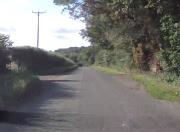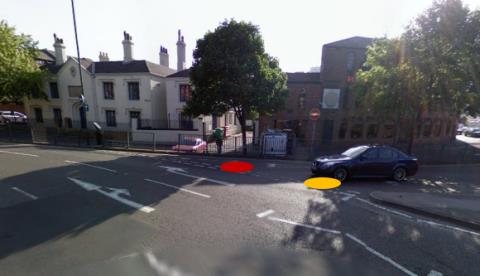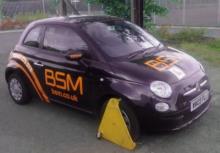I’ve had several people find the blog on the search term “can I fail my driving test for rolling back?”
The short answer is yes, you can fail for rolling back – but not automatically. It all depends on how far you roll, the circumstances, and who else is around. For example:
- if you roll back a few centimetres you’re unlikely to fail
- if you roll back a few centimetres and there is a pedestrian walking behind you, you’re more likely to fail
- if you roll back significantly – and by that I am thinking of ¼ metre or more – you could very easily fail
- if you do it every time you try to move away you could very easily fail
It all comes down to the examiner’s interpretation of the actual situation, so it’s impossible to state what will and will not result in a fail.
Take a look at the post Your Driving Test Report Explained. Under the section on Moving Off, it says:
Do not allow the vehicle to roll back.
It’s as simple as that, so don’t do it and you won’t have anything to worry about! Any roll back is wrong, but examiners are usually reasonable and don’t always fail people for a single minor fault. In most cases a small backward roll of a few centimetres is not even recorded, and is usually a minor issue at most on your test. However, at some point a “small” roll becomes a “moderate” one, and the precise point at which that change occurs is easily influenced by pedestrians walking behind you. You could hurt them if you rolled into them, and the examiner will note that.
You need to learn to look around, assess situations, and use the handbrake when it is necessary. As I said above, the ideal scenario is that you move off without rolling back at all.
There is no reason why you should be worried about it on your test. It isn’t rocket science to be able to move off properly on a hill or gradient rather than worrying about being allowed to get away with doing it badly.
One final thing: although some examiners might (usually) accept a small roll, what is acceptable to one might not be acceptable to another. And the flip-side to that is that what you see as “small” roll might be seen as a bigger one by the examiner – and the examiner’s decision is final.
Can I fail if I roll back on my driving test?
Yes. It isn’t a guaranteed fail, but if you roll back too much – or if someone is behind you when you do it – it can be. Don’t do it and you won’t have anything to worry about. Make sure you can find the bite reliably and it is much less likely to happen.
How much do I have to roll back to fail my test?
You shouldn’t roll back at all. However, examiners are usually very reasonable over small amounts of roll back, so stay calm and deal with it properly. If you begin to roll back, apply the foot brake and, if necessary, the handbrake. Then try again to move off properly. There is no set distance that the examiner is working to, and it all depends on the situation at the time, and how you deal with it. It also depends on how much you do it, who or what is behind you, and how often it happens – rolling back every time you move off is asking for trouble. For example, one of my pupils forgot to put the car in gear when asked to drive off right at the start of his test in the test centre car park. The car park is on an incline, and he rolled back almost a metre. The examiner marked it as a driver fault because she knew he was nervous. If he’d have done that out on the road with cars behind, though, it would almost certainly have been a serious fault.
Why did I roll back?
You didn’t have enough bite. That can occur if you don’t lift the clutch pedal far enough, or if you aren’t in gear in the first place. Make sure you check that you have the correct gear selected before trying to move off again.
What should I do if I roll back?
Stop the car rolling immediately by finding the bite or by applying the foot brake and – if necessary – the handbrake. Restart the engine if you stalled, check that you have the correct gear selected, then set the gas and find the biting point. Make sure you know how to find the bite.
Why is rolling back wrong?
If you roll back, then you’re not in control of the car. Not being in control is enough to get you a serious fault on your driving test. In reality, a very small roll back is likely to go unmarked on the test, though if it happens repeatedly or at the wrong time, it may get picked up.
The problem is that the car could weigh in the region of 2 tonnes, and if that sort of weight pushes against the knee of, say, a pedestrian walking behind you, it could cripple them. If it were a child, it might easily kill them. Of course, many people do roll back a little quite frequently by a few centimetres. Some people roll back a long way, though, and since I started driving many moons ago I’ve had people roll back into me more than once – do that on your test, and it is a deserved fail. These days, if someone is rolling towards me – and I keep my distance – I sound my horn to let them know I’m there.
If you start to roll back, use the brake – don’t sit there with the stunned rabbit-in-the-headlights glaze. Do something to stop it, then figure out quickly why it happened before trying to move off again.
What if I hit someone when I roll back?
I’ve noticed a small blip in traffic to this article from a cycling website, where a driver rolled back into a cyclist (no harm done to either party). The cycling fraternity viewpoint is that the motorist was absolutely in the wrong. The motorist appears to have been of the opinion that the cyclist was in the wrong.
Actually, they both were to some extent. Fortunately, no one was hurt, so it might best serve as a lesson to be learned. Motorists shouldn’t roll back – but in the real world, some do. Cyclists shouldn’t put themselves in a position where they are more likely to get hurt if it happens – but in the real world, some do. Sure, the motorist will most probably be the one who is prosecuted if someone is hurt – and in this case, the motorist appears to have been a complete prat anyway – but you need your head looking at if you think that that would somehow compensate for having both your legs crushed along with your bike.
 My evening pupil cancelled his lesson earlier today (stuck at work). Yesterday, another pupil had moved his evening lesson tomorrow into a cancellation slot I’d just acquired earlier in the day. So I sensed a free afternoon today when my two o’clock pupil jumped at the chance to move her lesson to 6pm tomorrow. I needed to go to the bank anyway.
My evening pupil cancelled his lesson earlier today (stuck at work). Yesterday, another pupil had moved his evening lesson tomorrow into a cancellation slot I’d just acquired earlier in the day. So I sensed a free afternoon today when my two o’clock pupil jumped at the chance to move her lesson to 6pm tomorrow. I needed to go to the bank anyway.


